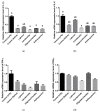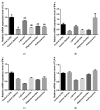Effect of Carotenoids, Oligosaccharides and Anthocyanins on Growth Performance, Immunological Parameters and Intestinal Morphology in Broiler Chickens Challenged with Escherichia coli Lipopolysaccharide
- PMID: 32098265
- PMCID: PMC7070938
- DOI: 10.3390/ani10020347
Effect of Carotenoids, Oligosaccharides and Anthocyanins on Growth Performance, Immunological Parameters and Intestinal Morphology in Broiler Chickens Challenged with Escherichia coli Lipopolysaccharide
Abstract
This study was conducted to investigate the effect of carotenoid, oligosaccharide and anthocyanin supplementation in broiler diets under Escherichia coli lipopolysaccharide (LPS) challenge. Ross 308 chickens were fed 5 diets: basal diet (control diet), diet supplemented with β-glucan in 0.05% (positive control) and diets with 0.5% carotenoid-, oligosaccharide- or anthocyanin contents. On the 26th days of age, chickens were challenged intraperitoneally 2 mg LPS per kg of body weight. 12 h after injection, birds were euthanized, then spleen and ileum samples were collected. LPS induced increased relative mRNA expression of splenic (p = 0.0445) and ileal (p = 0.0435) interleukin-1β (IL-1β), which was lower in the spleen in carotenoid (p = 0.0114), oligosaccharide (p = 0.0497) and anthocyanin (p = 0.0303)-treated chickens compared to LPS-injected control birds. Dietary supplementation of carotenoids also decreased relative gene expression of splenic interleukin-6 (IL-6) (p = 0.0325). In the ileum, β-glucan supplementation showed lower relative mRNA expression of toll-like receptor 5 (TLR-5) (p = 0.0387) compared to anthocyanin treatment. Gene expression of both splenic and ileal interferon-α (IFN-α), interferon-γ (IFN-γ), toll-like receptor 4 (TLR-4) and toll-like receptor 5 (TLR-5) were not influenced by dietary supplements. In conclusion, carotenoids, oligosaccharides and anthocyanins could partially mitigate the immune stress caused by LPS challenge. All of the compounds impacted longer villus height (p < 0.0001), villus height:crypt depth ratios were higher after β-glucan (p < 0.0001) and anthocyanin (p = 0.0063) supplementations and thickened mucosa was observed in β-glucan (p < 0.0001), oligosaccharide (p < 0.0001) and anthocyanin (p = 0.048) treatments. All of these findings could represent a more effective absorption of nutrients.
Keywords: anthocyanins; broiler chicken; carotenoids; cytokines; gene expression; intestinal morphology; natural compounds; oligosaccharides; receptors; β-glucan.
Conflict of interest statement
The authors declare no conflict of interest. The funders had no role in the design of the study; in the collection, analyses, or interpretation of data; in the writing of the manuscript, or in the decision to publish the results.
Figures






Similar articles
-
Dietary l-threonine supplementation attenuates lipopolysaccharide-induced inflammatory responses and intestinal barrier damage of broiler chickens at an early age.Br J Nutr. 2018 Jun;119(11):1254-1262. doi: 10.1017/S0007114518000740. Br J Nutr. 2018. PMID: 29770758 Clinical Trial.
-
Capsanthin supplementation modulates the immune response in broiler chickens under Escherichia coli lipopolysaccharide challenge.Arch Anim Breed. 2023 Mar 2;66(1):103-111. doi: 10.5194/aab-66-103-2023. eCollection 2023. Arch Anim Breed. 2023. PMID: 37312865 Free PMC article.
-
The effect of dietary fructooligosaccharide supplementation on growth performance, intestinal morphology, and immune responses in broiler chickens challenged with Salmonella Enteritidis lipopolysaccharides.Poult Sci. 2015 Dec;94(12):2887-97. doi: 10.3382/ps/pev275. Epub 2015 Oct 13. Poult Sci. 2015. PMID: 26467012
-
Innate immune response to yeast-derived carbohydrates in broiler chickens fed organic diets and challenged with Clostridium perfringens.Poult Sci. 2012 May;91(5):1105-12. doi: 10.3382/ps.2011-02109. Poult Sci. 2012. PMID: 22499867 Clinical Trial.
-
Dietary supplementation with anthocyanin attenuates lipopolysaccharide-induced intestinal damage through antioxidant effects in yellow-feathered broiler chicks.Poult Sci. 2023 Feb;102(2):102325. doi: 10.1016/j.psj.2022.102325. Epub 2022 Nov 24. Poult Sci. 2023. PMID: 36566655 Free PMC article.
Cited by
-
Nutraceuticals Induced Changes in the Broiler Gastrointestinal Tract Microbiota.mSystems. 2021 Mar 2;6(2):e01124-20. doi: 10.1128/mSystems.01124-20. mSystems. 2021. PMID: 33653943 Free PMC article.
-
Potential Effects of Anthocyanin-Rich Roselle (Hibiscus sabdariffa L.) Extract on the Growth, Intestinal Histomorphology, Blood Biochemical Parameters, and the Immune Status of Broiler Chickens.Antioxidants (Basel). 2022 Mar 13;11(3):544. doi: 10.3390/antiox11030544. Antioxidants (Basel). 2022. PMID: 35326194 Free PMC article.
-
Comparison of the Modulating Effect of Anthocyanin-Rich Sour Cherry Extract on Occludin and ZO-1 on Caco-2 and HUVEC Cultures.Int J Mol Sci. 2022 Aug 12;23(16):9036. doi: 10.3390/ijms23169036. Int J Mol Sci. 2022. PMID: 36012299 Free PMC article.
-
Measuring the impact of dietary supplementation with citrus or cucumber extract on chicken gut microbiota using 16s rRNA gene sequencing.Vet Res Commun. 2024 Aug;48(4):2369-2384. doi: 10.1007/s11259-024-10417-w. Epub 2024 May 23. Vet Res Commun. 2024. PMID: 38780824 Free PMC article.
-
Preparation, characterization, pharmacokinetics and ulcerative colitis treatment of hyperoside-loaded mixed micelles.Drug Deliv Transl Res. 2024 May;14(5):1370-1388. doi: 10.1007/s13346-023-01470-0. Epub 2023 Nov 13. Drug Deliv Transl Res. 2024. PMID: 37957475
References
-
- Zhang B., Guo Y., Wang Z. The modulating effect of β-1,3/1,6-glucan supplementation in the diet on performance and immunological responses of broiler chickens. Asian-Australas. J. Anim. Sci. 2008;21:237–244. doi: 10.5713/ajas.2008.70207. - DOI
-
- Bartholomew M.J., Hollinger K., Vose D. Characterizing the risk of antimicrobial use in food animals: Fluoroquinolone-resistant Campylobacter from consumption of chicken. In: Torrence M.E., Isaacson R.E., editors. Microbial Food Safety in Animal Agriculture: Current Topics. Iowa State Press; Ames, IA, USA: 2003. pp. 293–301.
Grants and funding
LinkOut - more resources
Full Text Sources

